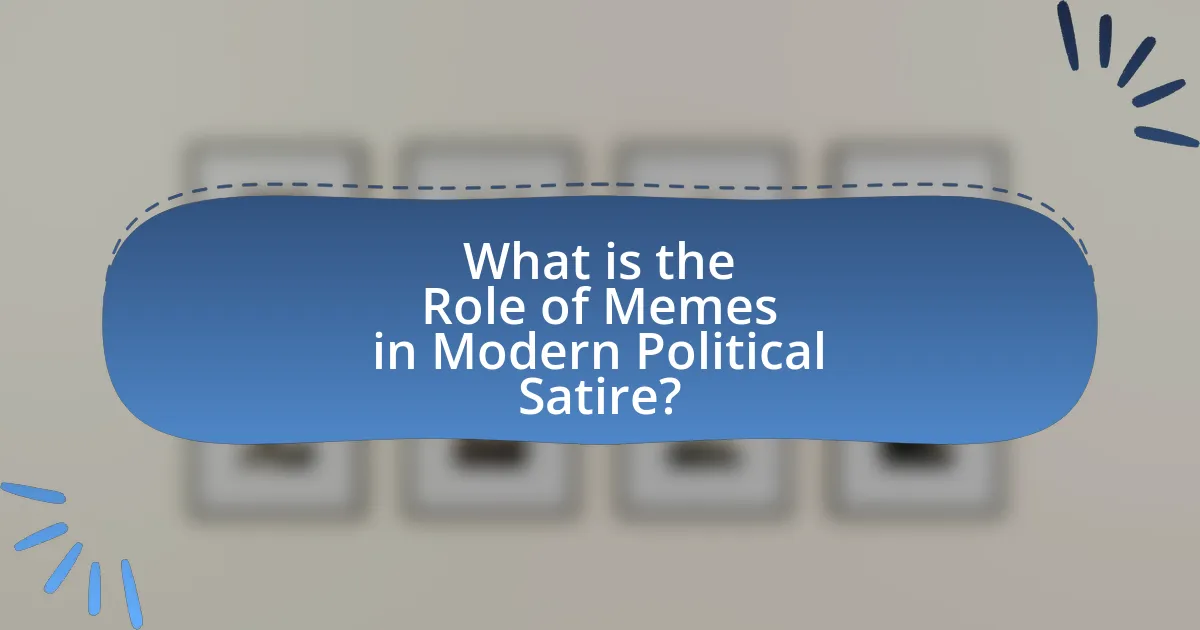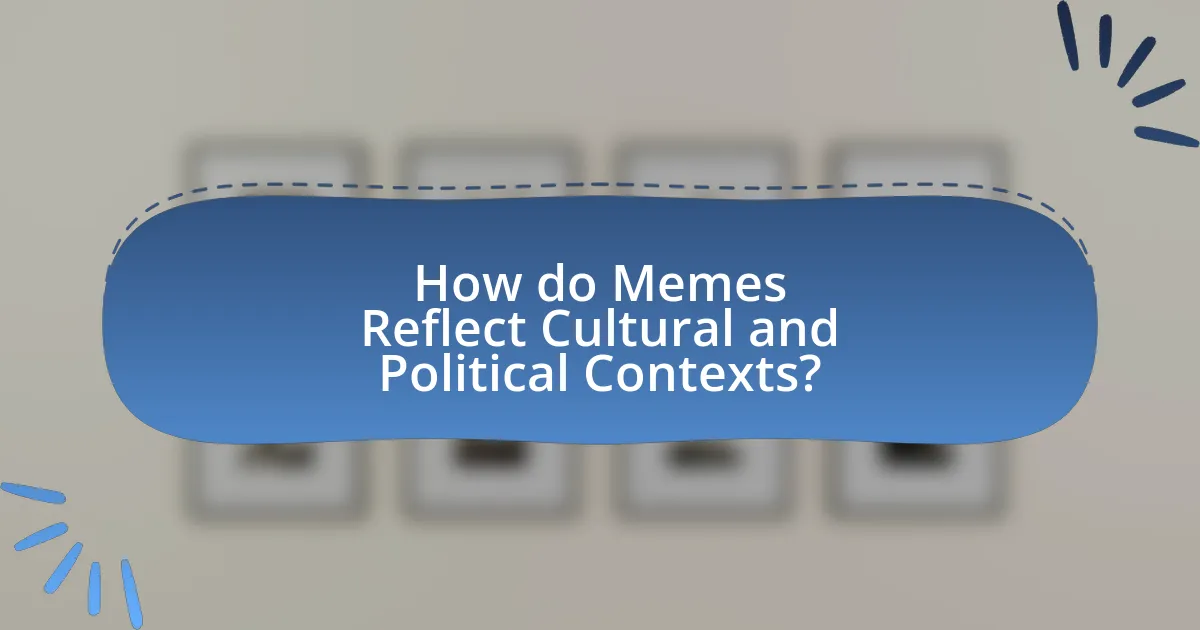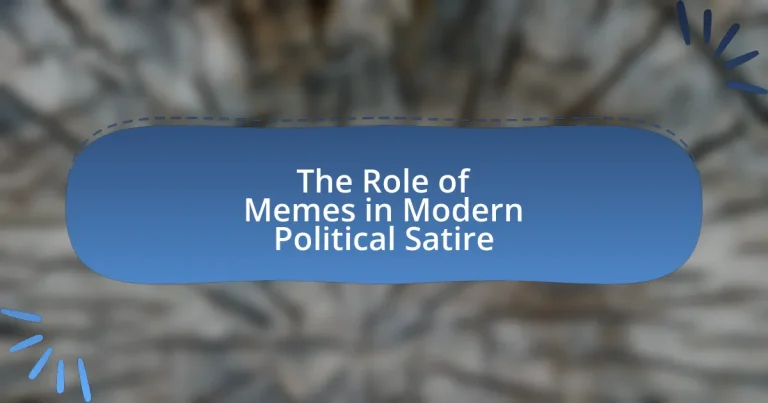The article examines the role of memes in modern political satire, highlighting their function as a rapid and accessible means of commentary on political events and figures. It discusses how memes simplify complex political issues, enhance engagement, and influence public perception, particularly among younger audiences. Key characteristics of political memes, their impact on political discourse, and their ability to reflect cultural contexts are analyzed, along with ethical considerations surrounding misinformation and the responsibilities of meme creators. The article also explores how memes serve as tools for protest and resistance, empowering marginalized voices in political discussions.

What is the Role of Memes in Modern Political Satire?
Memes play a crucial role in modern political satire by serving as a rapid and accessible means of commentary on political events and figures. They simplify complex political issues into easily digestible visuals and text, allowing for widespread dissemination and engagement across social media platforms. For instance, during the 2016 U.S. presidential election, memes became a significant tool for both supporters and opponents of candidates, influencing public perception and voter sentiment. Research indicates that memes can shape political discourse by reinforcing existing beliefs and providing a platform for humor and critique, as evidenced by studies showing increased engagement and sharing of political content in meme format compared to traditional news articles.
How do memes function as a form of political commentary?
Memes function as a form of political commentary by distilling complex political issues into easily digestible and shareable visual formats. This simplification allows for rapid dissemination of ideas, often using humor or satire to critique political figures, policies, or societal norms. For instance, during the 2016 U.S. presidential election, memes played a significant role in shaping public perception, with viral images and captions influencing voter opinions and engagement on social media platforms. Research indicates that memes can effectively mobilize political discourse, as they resonate with younger audiences who are more likely to engage with visual content.
What are the key characteristics that define political memes?
Political memes are characterized by their ability to convey political messages through humor, satire, and visual imagery. These memes often utilize recognizable symbols, such as political figures or events, to create relatable content that resonates with audiences. The use of irony and exaggeration is common, allowing for critical commentary on political issues while engaging viewers emotionally. Additionally, political memes are typically shared rapidly across social media platforms, amplifying their reach and impact. Research indicates that memes can influence public opinion and political discourse, as they simplify complex ideas into digestible formats, making them accessible to a broader audience.
How do memes convey complex political ideas succinctly?
Memes convey complex political ideas succinctly by utilizing visual imagery and concise text to encapsulate multifaceted concepts. This method allows for rapid comprehension and engagement, as the combination of humor and relatability makes intricate political issues more accessible to a broader audience. For instance, a meme depicting a politician with a humorous caption can highlight a specific policy failure or social issue, prompting viewers to reflect on the underlying complexities without requiring extensive explanation. Research indicates that memes can enhance information retention and stimulate discussion, as they often serve as a catalyst for sharing and dialogue on social media platforms.
Why have memes become a popular tool in political discourse?
Memes have become a popular tool in political discourse due to their ability to convey complex ideas quickly and humorously. This rapid dissemination of information is facilitated by social media platforms, where memes can reach a wide audience almost instantaneously. Research indicates that memes can simplify political messages, making them more accessible and relatable to the general public, which enhances engagement and discussion around political issues. For instance, a study by the Pew Research Center found that 55% of social media users have encountered political memes, highlighting their prevalence and impact in shaping public opinion.
What factors contribute to the virality of political memes?
The virality of political memes is primarily influenced by their relatability, humor, emotional resonance, and shareability. Relatable content connects with audiences by reflecting shared experiences or sentiments, making them more likely to engage and share. Humor enhances the appeal, as funny memes are more memorable and enjoyable, prompting users to disseminate them further. Emotional resonance, whether through satire, outrage, or joy, drives engagement, as people are inclined to share content that elicits strong feelings. Lastly, the ease of sharing on social media platforms amplifies the reach of these memes, facilitating rapid dissemination among users. Studies have shown that memes that combine these elements can achieve exponential sharing rates, significantly impacting political discourse.
How do social media platforms influence meme dissemination?
Social media platforms significantly influence meme dissemination by providing rapid and widespread channels for sharing content. These platforms, such as Twitter, Facebook, and Instagram, utilize algorithms that prioritize engaging content, allowing memes to reach larger audiences quickly. For instance, a study by the Pew Research Center found that 55% of U.S. adults reported encountering memes on social media, highlighting their prevalence. Additionally, the interactive nature of these platforms encourages users to remix and share memes, further amplifying their reach and impact in political discourse. This dynamic fosters a culture where memes can shape public opinion and political satire effectively.
What impact do memes have on public perception of political figures?
Memes significantly shape public perception of political figures by simplifying complex issues and creating relatable content that resonates with audiences. This impact is evident in how memes can enhance or undermine a political figure’s image, often leading to viral dissemination of both positive and negative portrayals. For instance, during the 2016 U.S. presidential election, memes played a crucial role in shaping perceptions of candidates, with studies indicating that humorous or satirical memes could influence voter opinions and engagement levels. Research from the Pew Research Center shows that 55% of social media users encountered political memes, highlighting their prevalence and potential to sway public sentiment.
How do memes shape the narrative around political events?
Memes shape the narrative around political events by simplifying complex issues and making them more relatable to the public. They often use humor and satire to critique political figures or policies, which can influence public perception and discourse. For instance, during the 2016 U.S. presidential election, memes played a significant role in shaping opinions about candidates, with viral images and videos impacting voter sentiment and engagement. Research by the Pew Research Center indicates that 55% of social media users encountered political memes, highlighting their prevalence and potential to sway opinions.
What role do memes play in reinforcing or challenging political ideologies?
Memes play a significant role in both reinforcing and challenging political ideologies by serving as tools for communication and persuasion. They can reinforce ideologies by simplifying complex political messages into easily digestible formats that resonate with specific audiences, thereby solidifying existing beliefs. For instance, memes that depict political figures in a humorous or exaggerated manner can strengthen supporters’ loyalty and create a sense of community among like-minded individuals. Conversely, memes can challenge political ideologies by critiquing or mocking opposing views, often using satire to highlight contradictions or failures. Research indicates that memes can influence public opinion by shaping perceptions and encouraging critical thinking, as seen in the viral spread of memes during political events like the 2016 U.S. presidential election, where both supporters and opponents utilized memes to sway voters.

How do Memes Reflect Cultural and Political Contexts?
Memes reflect cultural and political contexts by serving as a medium for social commentary and collective expression. They encapsulate prevailing sentiments, ideologies, and reactions to current events, often using humor or satire to critique political figures or societal norms. For instance, during the 2016 U.S. presidential election, memes like “Pepe the Frog” became symbols of various political movements, illustrating how digital imagery can convey complex political messages and cultural identities. Research by Limor Shifman in “Memes in Digital Culture” highlights that memes not only reflect but also shape public discourse, demonstrating their role in influencing perceptions and mobilizing communities around specific cultural or political issues.
What cultural elements are often incorporated into political memes?
Political memes often incorporate cultural elements such as popular music, television shows, movies, and internet trends. These elements serve to enhance relatability and humor, making the political message more accessible to a wider audience. For instance, memes that reference iconic scenes from films or catchphrases from popular songs can quickly resonate with viewers, leveraging shared cultural knowledge to convey political commentary effectively. This technique is supported by the fact that memes often rely on intertextuality, where the meaning is derived from the relationship between the meme and the cultural references it employs, thus amplifying the political message through familiar contexts.
How do memes adapt to different political climates?
Memes adapt to different political climates by reflecting the prevailing sentiments, ideologies, and events relevant to those contexts. For instance, during election cycles, memes often target candidates’ policies or public personas, utilizing humor and satire to engage audiences and influence opinions. A notable example is the use of memes during the 2016 U.S. presidential election, where both supporters and opponents of candidates like Donald Trump and Hillary Clinton created content that resonated with their respective bases, amplifying political messages and mobilizing voters. This adaptability is facilitated by the rapid dissemination of memes through social media platforms, allowing them to evolve quickly in response to changing political narratives and public reactions.
What historical events have significantly influenced meme content?
The rise of the internet and social media platforms has significantly influenced meme content, particularly during key historical events such as the 2008 U.S. presidential election and the COVID-19 pandemic. The 2008 election saw the emergence of viral political memes, exemplified by the “Yes We Can” campaign slogan, which was widely shared and remixed across platforms like Facebook and Twitter, demonstrating how digital culture can shape political discourse. Similarly, during the COVID-19 pandemic, memes became a primary means of communication and coping, with content reflecting public sentiment, misinformation, and humor about lockdowns and health guidelines, showcasing the adaptability of memes in response to global crises. These events illustrate how memes serve as a reflection of societal attitudes and can influence public perception and engagement in political matters.
How do memes serve as a form of protest or resistance?
Memes serve as a form of protest or resistance by enabling individuals to express dissent and critique authority in a humorous and accessible manner. This digital medium allows for rapid dissemination of ideas, often circumventing traditional censorship methods. For example, during the Arab Spring, memes were used to mobilize protests and criticize oppressive regimes, illustrating their effectiveness in political movements. Additionally, studies show that memes can shape public opinion and foster community among like-minded individuals, further amplifying their role in resistance efforts.
What examples illustrate the use of memes in social movements?
Memes have been effectively used in social movements to convey messages and mobilize support, with notable examples including the “We Are the 99%” meme during the Occupy Wall Street movement, which highlighted economic inequality, and the “This is Fine” dog meme, which became a symbol of climate change inaction. The “We Are the 99%” meme featured images of individuals holding signs that articulated their struggles against corporate greed, resonating widely and fostering solidarity among participants. Similarly, the “This is Fine” meme, depicting a dog in a burning room, encapsulated the absurdity of ignoring climate crises, gaining traction on social media platforms and sparking discussions about environmental policies. These examples demonstrate how memes can encapsulate complex issues in a relatable format, driving engagement and awareness in social movements.
How do memes empower marginalized voices in political discussions?
Memes empower marginalized voices in political discussions by providing a platform for expression that is accessible and easily shareable. This democratization of content allows individuals from underrepresented communities to communicate their perspectives and critique dominant narratives without the barriers typically associated with traditional media. For instance, during the Black Lives Matter movement, memes circulated widely on social media, amplifying messages about racial injustice and police brutality, which mainstream media often overlooked. The viral nature of memes enables rapid dissemination of these ideas, fostering solidarity and mobilization among marginalized groups.

What are the Ethical Considerations Surrounding Political Memes?
The ethical considerations surrounding political memes include the potential for misinformation, the impact on public opinion, and the reinforcement of stereotypes. Political memes often simplify complex issues, which can lead to misinterpretation and the spread of false narratives, as evidenced by the viral nature of misleading memes during elections. Additionally, these memes can shape public perception by framing political figures or policies in a biased manner, influencing voter behavior. Furthermore, political memes may perpetuate harmful stereotypes, particularly regarding marginalized groups, which raises concerns about social responsibility and the potential for harm.
How can memes perpetuate misinformation in politics?
Memes can perpetuate misinformation in politics by simplifying complex issues into easily digestible and often misleading visuals or phrases. This simplification can distort facts, as memes frequently rely on humor or satire, which may lead audiences to accept exaggerated or false representations of political events or figures. Research indicates that memes can spread rapidly on social media platforms, reaching large audiences quickly; for instance, a study published in the journal “Political Communication” found that memes significantly influenced public perception during the 2016 U.S. presidential election, often reinforcing partisan biases and spreading false narratives.
What strategies can be employed to identify misleading memes?
To identify misleading memes, individuals can employ several strategies, including fact-checking, analyzing sources, and examining context. Fact-checking involves verifying the claims made in the meme against reliable sources, such as established news organizations or fact-checking websites like Snopes or FactCheck.org. Analyzing sources requires scrutinizing the origin of the meme, including the credibility of the creator and the platform where it was shared, as misinformation often originates from untrustworthy sources. Examining context entails understanding the broader situation surrounding the meme, including the timing and the specific political or social issues it addresses, as misleading memes often distort facts to fit a particular narrative. These strategies are essential in combating the spread of misinformation in political satire.
How do memes affect the credibility of political discourse?
Memes significantly undermine the credibility of political discourse by promoting misinformation and oversimplifying complex issues. The rapid spread of memes on social media platforms often leads to the dissemination of exaggerated or false narratives, which can distort public perception and influence political opinions. Research by the Pew Research Center indicates that 64% of Americans believe fabricated news stories cause confusion about basic facts, highlighting the detrimental impact of memes on informed political discussions. Furthermore, memes frequently rely on humor and satire, which can lead audiences to dismiss serious topics, thereby reducing the overall quality of political dialogue.
What responsibilities do meme creators have in political satire?
Meme creators in political satire have the responsibility to ensure accuracy, promote critical thinking, and avoid spreading misinformation. By accurately representing political figures and events, they contribute to informed public discourse. For instance, memes that distort facts can mislead audiences, as seen in the 2016 U.S. presidential election, where false memes significantly influenced voter perceptions. Additionally, meme creators should encourage critical engagement by prompting audiences to question and analyze political narratives rather than passively consuming content. This responsibility is crucial in an era where social media amplifies the reach of satirical content, making it essential for creators to consider the potential impact of their work on public opinion and democratic processes.
How can creators balance humor and accuracy in political memes?
Creators can balance humor and accuracy in political memes by ensuring that the comedic elements do not distort the factual basis of the political message. This involves using satire to highlight real issues while maintaining a commitment to truthfulness. For instance, a meme that exaggerates a politician’s statement can still reference the actual quote to provide context, thus preserving accuracy. Research indicates that memes that blend humor with factual information are more likely to engage audiences effectively, as they stimulate both emotional and cognitive responses (Bennett & Segerberg, 2013, “The Logic of Connective Action”). By prioritizing factual accuracy alongside humor, creators can foster informed discussions while entertaining their audience.
What are the potential consequences of harmful political memes?
Harmful political memes can lead to significant societal consequences, including the spread of misinformation, polarization of public opinion, and the erosion of trust in democratic institutions. Misinformation propagated through these memes can distort facts, influencing voters’ perceptions and decisions, as evidenced by studies showing that false information spreads faster on social media than accurate information. Additionally, harmful memes often reinforce existing biases, contributing to increased political polarization, which can result in social unrest and division within communities. The erosion of trust in institutions occurs when memes undermine the credibility of political figures and organizations, leading to a disengaged electorate and weakened democratic processes.
What best practices can enhance the effectiveness of political memes?
To enhance the effectiveness of political memes, creators should focus on clarity, relatability, and emotional appeal. Clarity ensures that the message is easily understood, which is crucial given the rapid consumption of content on social media platforms. Relatability allows the audience to connect with the meme on a personal level, increasing the likelihood of sharing. Emotional appeal, whether through humor, outrage, or empathy, can drive engagement and provoke discussions. Research indicates that memes that evoke strong emotions are more likely to be shared, as demonstrated in a study by the University of Pennsylvania, which found that emotionally charged content significantly increases user interaction.
How can meme creators engage their audience more effectively?
Meme creators can engage their audience more effectively by leveraging relatability and current events to create content that resonates with viewers. By tapping into shared experiences or popular culture references, creators can foster a sense of community and connection among their audience. For instance, memes that reference trending political issues or viral moments tend to gain traction, as they reflect the collective sentiment and humor of the moment. Research indicates that memes that evoke emotional responses, such as humor or nostalgia, are more likely to be shared, enhancing audience engagement. This strategy is supported by the fact that memes often serve as a form of social commentary, allowing creators to express opinions while inviting audience interaction through comments and shares.
What tools and resources are available for creating impactful political memes?
Various tools and resources are available for creating impactful political memes, including graphic design software, meme generators, and social media platforms. Graphic design software like Adobe Photoshop and Canva allows users to create custom images and add text, enhancing the visual appeal and message of the memes. Meme generators such as Imgflip and Meme Generator provide templates and easy-to-use interfaces for quick meme creation, catering to users with varying levels of design skills. Additionally, social media platforms like Twitter, Instagram, and Facebook serve as both distribution channels and sources of inspiration, where users can observe trending political memes and engage with audiences effectively. These tools collectively empower creators to produce memes that resonate with political discourse and engage viewers.

